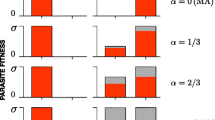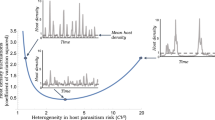Abstract
We explore evolutionarily stable co-evolution of host-macroparasite interactions in a discrete-time two-species population dynamics model, in which the dynamics may be stable, cyclic or chaotic. The macroparasites are assumed to harm host individuals through decreased reproductive output. Hosts may develop costly immune responses to defend themselves against parasites. Parasites compete with conspecifics by adjusting their fecundities. Overall, the presence of both parasites and the immune response in hosts produces more stable dynamics and lower host population sizes than that observed in the absence of the parasites. In our evolutionary analyses, we show that maximum parasite fecundity is always an evolutionarily stable strategy (ESS), irrespective of the type of population interaction, and that maximum parasite fecundity generally induces a minimum parasite population size through over-exploitation of the host. Phenotypic polymorphisms with respect to immunity in the host species are common and expected in ESS host strategies: the benefits of immunication depend on the frequency of the immune hosts in the population. In particular, the steady-state proportions of immune hosts depend, in addition to all the parameters of the parasite dynamics only on the cost of immunity and on the virulence of parasites in susceptible hosts. The implicit ecological dynamics of the host-parasite interaction affect the proportion of immune host individuals in the population. Furthermore, when changes in certain population parameters cause the dynamics of the host-parasite interaction to move from stability to cyclicity and then to chaos, the proportion of immune hosts tends to decrease; however, we also detected counter-examples to this result. As a whole, incorporating immunological and genetic aspects, as well as life-history trade-offs, into host-macroparasite dynamics produces a rich extension to the patterns observed in the models of ecological interactions and epidemics, and deserves more attention than is currently the case.
Similar content being viewed by others
References
Anderson, R. M. and R. M. May. 1978. Regulation and stability of host-parasite population interactions. I. Regulatory processes.J. Anim. Ecol.,47, 219–247.
Anderson, R. M. and R. M. May. 1991.Infectious Diseases of Humans. Dynamics and Control. New York: Oxford University Press.
Bellows, T. S. J. 1981. The descriptive properties of some models for density dependence.J. Anim. Ecol. 50, 139–156.
Beverton, R. J. H. and S. J. Holt. 1957. On the dynamics of exploited populations.Fishery Investment Series 2, Vol. 19. London: U. K. Ministry of Agriculture and Fisheries.
Bremermann, H. J. and J. Pickering. 1983. A game-theoretic model of parasite virulence.J. Theor. Biol. 100, 411–426.
Edelstein-Keshet, L. 1988.Mathematical Models in Biology. New York: Random House.
Ferrière, R. and M. Gatto. 1995. Lyapunov exponents and the mathematics of invasion in oscillatory and chaotic populations.Theor. Popul. Biol. 48, 126–171.
Frank, S. A. 1992. A kin selection model for the evolution of virulence.Proc. Roy. Soc. London Ser. B 250, 195–197.
Gatto, M. 1993. The evolutionary optimality of oscillatory and chaotic population dynamics in simple population models.Theor. Popul. Biol. 43, 310–336.
Getz, W. M. 1996. A hypothesis regarding the abruptness of density dependence and the growth rate of populations.Ecology 77, 2014–2026.
Gregory, R. D., A. E. Keymer and J. R. Clarke. 1990. Genetics, sex and exposure: the ecology ofHeligmosomoides polygurus (Nematoda) in the wood mouse.J. Anim. Ecol. 59, 363–378.
Haldane, J. B. S. 1949. Disease and evolution.La Ricerca Sci. Suppl.,19, 68–76.
Hassell, M. P. 1978.The Dynamics of Arthropod Predator-Prey Systems.Monographs in Population Biology, Vol. 13. Princeton: Princeton University Press.
Heesterbeek, J. A. P. and M. G. Roberts. 1995. Mathematical models for microparasites of wildlife. In:Ecology of Infectious Diseases in Natural Populations, B. T. Grenfell and A. P. Dobson (Eds), pp. 90–122. Cambridge: Cambridge University Press.
Kaitala, A., V. Kaitala and P. Lundberg. 1993. A theory of partial migration.Am. Nat. 142 59–81.
Kaitala, V. and W. M. Getz. 1995. Population dynamics and harvesting of semelparous species with phenotypic and genotypic variability in reproductive age.J. Math. Biol. 33, 521–556.
Kaitala, V. and M. Heino. 1996. Complex non-unique dynamics in simple ecological interactions.Proc. Roy. Soc. London Ser. B 263, 1011–1015.
Kaitala, V., A. Kaitala and W. M. Getz. 1989. Evolutionary stable dispersal of a waterstrider in a temporally and spatially heterogeneous environment.Evol. Ecol. 3, 283–298.
Keymer, A. E., A. B. Tarlton, R. W. Hiorns, C. E. Lawrence and D. I. Pritchard. 1990. Immunogentic correlates of susceptibility to infection withHeligmosomoides polygyrus in outbread mice.Parasitology 101, 69–73.
Knolle, H. 1989. Host density and the evolution of parasite virulence.J. Theor. Biol. 136, 199–207.
Maizels, R. M., D. A. P. Bundy, M. E. Selkirk, D. F. Smith and R. M. Anderson. 1993. Immunological modulation and evasion by helminth parasites in human populations.Nature 365, 797–805.
May, R. M. 1974. Biological populations with non-overlapping generations: stable points, stable cycles and chaos.Science 186, 645–647.
May, R. M. 1976. Simple mathematical models with very complicated dynamics.Nature 261, 459–467.
May, R. M. 1978. Host-parasitoid systems in patchy environments: a phenomenological model.J. Anim. Ecol. 47, 833–843.
May, R. M. and R. M. Anderson. 1978. Regulation and stability of host-parasite population interactions. II. Destabilizing processes.J. Anim. Ecol. 47, 249–267.
Maynard Smith, J. and M. Slatkin. 1973. The stability of predator-prey systems.Ecology 54, 384–391.
Peitgen, H.-O., H. Jürgens and D. Saupe. 1992.Chaos and Fractals. New Frontiers of Science. New York: Springer-Verlag.
Rand, D. A., H. B. Wilson and J. M. McGlade. 1994. Dynamics and evolution: evolutionarily stable attractors, invasion exponents and phenotypic dynamics.Phil. Trans. Roy. Soc. London Ser. B 343, 261–283.
Read, A. F.. 1995. Genetics and evolution of infectious diseases in natural populations. Group report. InEcology of Infectious Diseases in Natural Populations, B. T. Grenfell and A. P. Dobson (Eds), pp. 450–477. Cambridge: Cambridge University Press.
Roberts, M. G., G. Smith and B. T. Grenfell. 1995. Mathematical models for macroparasites of wildlife. InEcology of Infectious Diseases in Natural Populations, B. T. Grenfell and A. P. Dobson (Eds), pp. 177–208. Cambridge: Cambridge University Press.
Ross, R. 1915. Some a priori pathometric equations.Brit. Med. J. 1, 546–547.
Ross, R. 1916. An application of the theory of probabilities to the study of a priori pathometry, I.Proc. Roy. Soc. London Ser. A 92, 204–230.
Ross, R. and H. P. Hudson. 1917. An application of the theory of probabilities to the study of a priori pathometry, II.Proc. Roy, Soc. London Ser. A 93, 212–225.
Schad, G. A. and R. M. Anderson. 1985. Predisposition to hookworm infection in humans.Science 228, 1537–1540.
Sheldon, B. C. and S. Verhulst. 1996. Ecological immunology: costly parasite defences and trade-offs in evolutionary ecology.Trends Ecol. Evol. 11, 317–321.
Shepherd, J. G. 1982. A versatile new stock-recruitment relationship for fisheries, and the construction of sustainable yield curves.J. Cons. Int. Explor. Mer. 40, 67–75.
Taylor, P. D. 1989. Evolutionary stability in one-parameter models under weak selection.Theor. Popul. Biol. 36, 125–143.
Vincent, T. L. and J. S. Brown. 1984. Stability in an evolutionary game.Theor. Popul. Biol. 26, 408–427.
Vincent, T. L. and J. S. Brown. 1987. Evolution under nonequilibrium dynamics.Math. Model. 8, 766–771.
Vincent, T. L. and J. S. Brown. 1988. The evolution of ESS theory.Ann. Rev. Ecol. Syst. 19, 423–443.
Wakelin, D. 1992. Immunogentic and evolutionary influences on the host-parasite relationship.Dev. Comp. Immunol.,16, 345–353.
Wassom, D. L., V. M. Guss and A. W. Grundmann. 1973. Host resistance in a natural host-parasite system. Resistance toHymenolepsis citelli byPeromyscus maniculatus.J. Parasitol. 59, 117–121.
Wassom, D. L., C. W. DeWitt and A. W. Grundmann. 1974. Immunity toHymenolepsis citelli byPeromyscus maniculatus: genetic control and ecological implications.J. Parasitol. 60, 47–52.
Wassom, D. L., T. A. Dick, N. Arnason, D. Strickland and A. W. Grundmann. 1986. Host genetics: a key factor regulating the distribution of parasites in natural host populations.J. Parasitol. 72, 334–337.
Author information
Authors and Affiliations
Corresponding author
Rights and permissions
About this article
Cite this article
Kaitala, V., Heino, M. & Getz, W.M. Host-parasite dynamics and the evolution of host immunity and parasite fecundity strategies. Bltn Mathcal Biology 59, 427–450 (1997). https://doi.org/10.1007/BF02459459
Received:
Accepted:
Issue Date:
DOI: https://doi.org/10.1007/BF02459459




